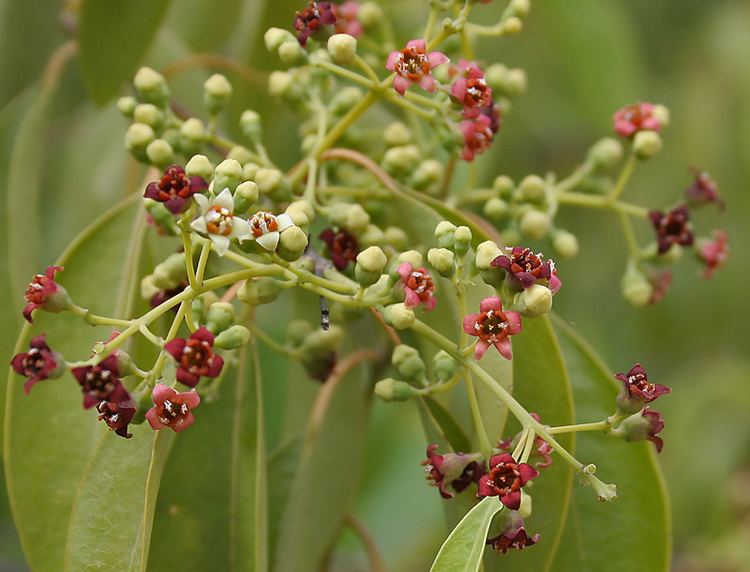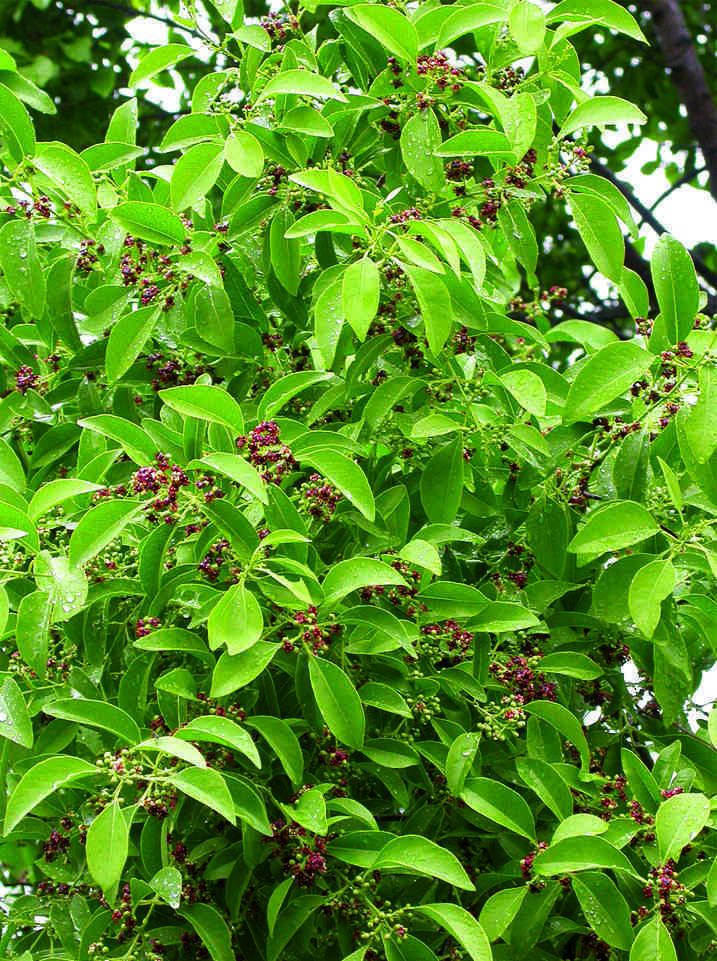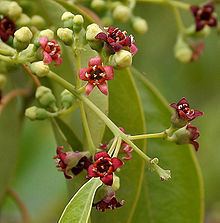Higher classification Santalum | Genus Santalum Rank Species | |
 | ||
Similar Narra, Red sandalwood, Patchouli, Bergamot orange, Ylang‑ylang | ||
Santalum album sreegandha chandan
Santalum album or Indian sandalwood is a small tropical tree, and is the most commonly known source of sandalwood. This species has historically been cultivated, processed and traded since ancient times. Certain cultures place great significance on its fragrant and medicinal qualities. The high value of the species has caused its past exploitation, to the point where the wild population is vulnerable to extinction. Indian sandalwood still commands high prices for its essential oil, but due to lack of sizable trees it is no longer used for fine woodworking as before. The plant is widely cultivated and long lived, although harvest is viable after 40 years. Etymologically it is derived from Sanskrit Chandanam > Sandanam > Sandalum > Sandal.
Contents
- Santalum album sreegandha chandan
- Chandan santalum album seeds plants supplier exporter essential oil absolute
- Description
- Nomenclature
- Distribution
- Habitat
- Conservation
- Uses
- Ethnopharmacological Uses
- References

Chandan santalum album seeds plants supplier exporter essential oil absolute
Description

The height of the evergreen tree is between 4 and 9 metres. They may live to one hundred years of age. The tree is variable in habit, usually upright to sprawling, and may intertwine with other species. The plant parasitises the roots of other tree species, with a haustorium adaptation on its own roots, but without major detriment to its hosts. An individual will form a non-obligate relationship with a number of other plants. Up to 300 species (including its own) can host the tree's development - supplying macronutrients phosphorus, nitrogen and potassium, and shade - especially during early phases of development. It may propagate itself through wood suckering during its early development, establishing small stands. The reddish or brown bark can be almost black and is smooth in young trees, becoming cracked with a red reveal. The heartwood is pale green to white as the common name indicates. The leaves are thin, opposite and ovate to lanceolate in shape. Glabrous surface is shiny and bright green, with a glaucous pale reverse. Fruit is produced after three years, viable seeds after five. These seeds are distributed by birds.
Nomenclature

The nomenclature for other "sandalwoods" and the taxonomy of the genus are derived from this species' historical and widespread use. Santalum album is included in the family Santalaceae, and is commonly known as white or East Indian sandalwood. The name, Santalum ovatum, used by Robert Brown in Prodromus Florae Novae Hollandiae (1810) was described as a synonym of this species by Alex George in 1984. The epithet album refers to the 'white' of the heartwood.

The species was the first to be known as sandalwood. Other species in the genus Santalum, such as the Australian S. spicatum, are also referred to as true sandalwoods, to distinguish them from trees with similar-smelling wood or oil.
Distribution
It is a hemiparasitic tree, native to semi-arid areas of the Indian subcontinent. It is now planted in India, China, Sri Lanka, Indonesia, Malaysia, the Philippines and Northern Australia.
Habitat
S. album occurs from coastal dry forests up to 700 m elevation. It normally grows in sandy or stony red soils, but a wide range of soil types are inhabited. This habitat has a temperature range from 0 to 38 °C and annual rainfall between 500 and 3000 mm.
Conservation
The species is threatened by over-exploitation and degradation to habitat through altered land use; fire, agriculture and land-clearing are the factors of most concern. To preserve this vulnerable resource from over-exploitation, legislation protects the species, and cultivation is researched and developed.
The Indian government has placed a ban on the export of the timber.
Uses
S. album has been the primary source of sandalwood and the derived oil. These often hold an important place within the societies of its naturalised distribution range. The high value of the plant has led to attempts at cultivation, this has increased the distribution range of the plant. The ISO Standard for the accepted characteristics of this essential oil is ISO 3518:2002. HPTLC and GC, GC-MS based methods are used for qualitative and quantitative analyses of the volatile essential oil constituents. The long maturation period and difficulty in cultivation have been restrictive to extensive planting within the range. Harvest of the tree involves several curing and processing stages, also adding to the commercial value. These wood and oil have high demand and are an important trade item in the regions of:
Ethnopharmacological Uses
Sandalwood oil has been widely used in folk medicine for treatment of common colds, bronchitis, skin disorders, heart ailments, general weakness, fever, infection of the urinary tract, inflammation of the mouth and pharynx, liver and gallbladder complaints and other maladies. Recently, the in vivo anti-hyperglycemic and antioxidant potentials of α-santalol and sandalwood oil were demonstrated in Swiss Albino mice. Additionally, different in vitro and in vivo parts of the plant have been shown to possess antimicrobial and antioxidant properties, possibly attributed to sesquiterpenoids, shikimic acid, etc.
